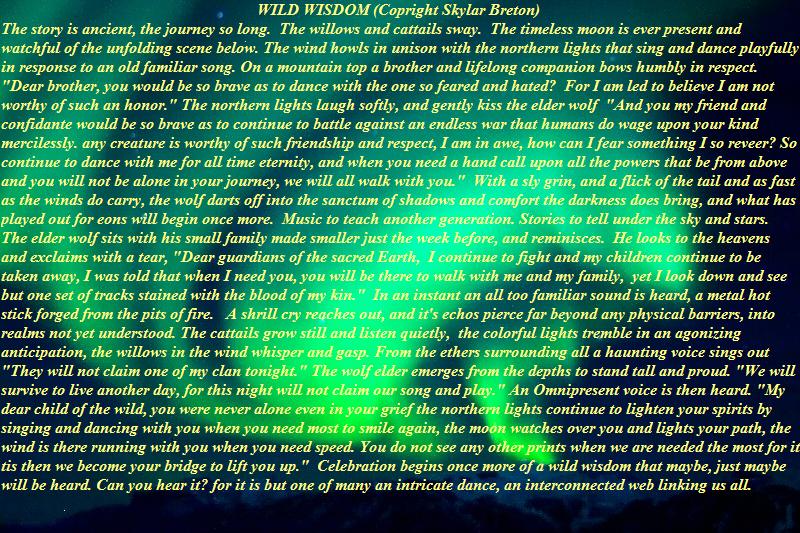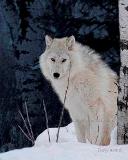|
(CLICK ON ANY PICS FOR LARGER VIEW)
An Arctic Encounter
A Wild Experience!
| sky and legend /eco march 09 |
|
|
Arctic
Wolf (Canis lupus arctos)
Legends
lineage is old and goes directly back to Northern Born, wild, High Arctic relatives.
About Arctic Wolves
Class:
Mammalia
Order:Carnivora
Family:
Canidae
Genus:
Canis
Scientific
Name: Canis lupus arctos
Weight:
Males can vary anywheres from 100 lbs to near 170 pounds, females tend to weigh a little less. Arctic wolves tend to be the
largest of the subspecies.
Height:
Arctic wolves can range in heights from a smaller female of approx 27" at the withers all the way to 35" at the withers.
Habitat:
As the name implies arctic wolves range is within the arctic regions, commonly confused with canis lupus hudsonicus (also
classifed as an arctic canidae) canis lupus arctos ranges from Melville island to Ellesmere island in the high canadian Arctic.
Arctic wolves are rare in captivity but numbers have slowly increased due in part to captive breeding. The Eurasian
arctic version of the arctos is called Canis lupus albus (Russian Tundra Wolf)
Status
in the wild: is unknown for certain, but are believed to be at risk even endangered. Many white wolves seen
in captivity are not arctic wolves but are arctic types, a combination of various subspecies to get an arctic looking white
wolf , (see Dharmas page as an example) not a true arctic wolf of pure blood. This of course is unfortunate. So be aware
that many places claiming to have arctics, simply do not. Arctic wolves will also disperse and follow
their prey, so they are known to travel great distances for survival.
Diet:
Lemmings, and Arctic hares comprise a lot of the wolves diet along with caribou depending on the arctic region, and
musk-oxen, but are opportunistic so will not pass up what is found such as arctic birds.
Habitat: Contrary to popular belief dens are used just to birth young and keep them safe for the first
number of months of their lives. They are not used by the pack for any other reason. In the arctic the land is very barren
and rocky, with high winds and frigid temps that can reach in excess of -65 degrees F. Arctic wolves
will curl up together to keep warm and use their tails like a scarf that will cover their noses, their ears are fairly short,
round and well furred to prevent freezing.
Physical descrip: Arctic
wolves are born darkly colored (not black) see pics on this page of legend as a puppy* and over the course of a couple
years phase into the glorious white coats so many are familiar with. There is NO SUCH thing as black arctics, you can
find black phase wolves found in the alaskan tundra range, (please visit eclipses page for more info.) but these are NOT *Arctos/Arctic wolves*
Their coats are longer in length than some other subspecies,
and stay white all year round once the color is attained, unlike arctic foxes or hares that change color with the season.
They tend to have a heavier look to them with thicker legs and wide skulls. Their OVERLY large furred feet act as snow shoes
to aid them through snowy/icey terrain. The fur under their feet is dense, and long enough to cover a lot of their paw pads
to help insulate them.
Their white coats act as good insulators against
the bitter arctic cold, due to each hair shaft having more airpockets than colored hair shafts like some other subspecies
have.
Gestation: Gestation
is the same as domestic dogs approx 63 days.
Breeding Time: Time of breeding depends on latitude, for Arctics this takes place a little later than more southern counterpart
subspecies, with mating taking place in March, and pups being whelped anywheres from early May till the end of May.
*Mech*
Number of pups born:
Arctic wolves tend to have smaller litters, with 3 being average, but have been known to give birth up ro 7 pups.
At approx 3 1/2 weeks of age pups start to become more active,
and will start to emerge from the den, pups are readily greeted by the entire pack whom will help to feed and care for
the fast growing pups. By approx 6 months of age, the pups must be grown enough to be able to keep up with the pack, and are
taught more indepth hunting methods via taking part in the hunts.
Lifespan: Arctic wolves in the
wild will be lucky to reach approx 7 years of age, as is any subspecies of gray wolf. Loss of habitat (displacement) starvation
(lack of food sources), weather elements, disease, injury either sustained within the pack (fighting) or via when hunting
a prey source, all play a part in how long a wild wolf may live. In captivity if a wolf has good vet care, regular
meals, and kept warm/safe from the elements, they can live to be up to 18 years of age. Due to nature ensuring only
the strongest and healthiest survive to pass on their genes, You will not find the same sort of diseases in frequency,
that plague domestic dogs. Bad genetics whether physically or otherwise, are very quickly weeded out, and don't survive
wild living.
Resource:
L. David Mech The Wolf : The ecology and behavior of
an endangered species
Jim Brandenburg: To the Top of the World; Adventures
with Arctic Wolves

| Unless otherwise marked all photos r taken by AWA |
|
|
| Photo of Legend By Judy Wood |
About Northern Lights Legend
Legend is a very mellow, sweet wolf, aptly nick named as a puppy as buddha baby, and
bup bup. I wrote a poem called Northern Lights Legend due to my fascination and ongoing dance, and love affair
with the aurora borealis. Legend was named after that fascination, and always seems to be smiling. We have yet to come upon
a more gentle sweet wolf.
However I also wish to impress upon the public that legend is but one individual and personality among
variant personalities that reside within wolves, and even with a bit more tractability, still not a dog, and thus cannot/should
not be raised like a dog in the house, nor in ways we train and treat our domestic dogs. Doing so will backfire
on the caretaker(s), in a very negative manner both for the animal, and the human(s).
Wolves even captive ones are still wild, and are NOT pets.
A Wolf Encounter does not endorse them being kept as such. A Wolf even in captivity need
to be allowed to be what they are ...wolves.
The facility needs to be prepared for the costly containment requirements, (zoo facilities have)
have vets willing to work with wolves, as well as understand ALL the psychological, physical, Nutritional needs of such
intense and high maintenance animals. Not to mention if any caretakers get ill are there other trained staff/volunteers/caretakers
there to continue adequate care of the wild charges.
Arctics are never born white, they are born darker and phase out whiter as they
age.
Wolf pups grow up to be large powerful animals and must be respected for what, and who
they are as individuals. I get asked a lot why wolf pups need to be pulled from mom so young, there are a variety of pros
and cons to this, the pros are legend is more safely handleable throughout his life having been socialized to humans,
at the same time great care must be taken for him to also be socialized to his own species so he does not over bond to humans
either.
Wolves that are bottlefed from before their eyes open will have a lot less stress in captive situations,
which alleviates pacing seen in so many zoo animals of past. Once old enough approx 4 -41/2 months they are placed with
older adult wolves, or with another well socialized trained canine (dog ) for a while longer to be that much more social as
adults.
Cons of being pulled away from mom and other wolf adults, are not being reared by their own kind
early on, as they naturally would be in the wild. Young pups can be a little more aggressive (nippy) during their
normal puppy stages, as they are not taught as well by humans (puppy manners) as they are by their own kind, when left
with them. To help make up for this, we use other well trained and social dogs to give the fast growing wolf pup the
necessities only another canine can offer.
Wolf pups absorb (look to) the best and the worst of their environments, so if they are
placed with spooky acting/skittish adults they will tend to also mimic such behaviors.
Wolf pups left with mom, like domestic dog pups are for 6-8 weeks, even if the dam is a social female,
will tend to be fearful and extremely shy of all humans. This strong trait is genetically passed onto pups for
survival in the wild, but in captive situations fearfulness can turn to aggression and this is potentially unsafe.
Many facilities are starting to realize keeping wild animals..wild acting, in captive situations can
be a stressfully painful experience for the animals.
Though somewhat* tamed* enough to be safer and handleable (not domesticated)
some other professional colleagues may argue the usage of this word, wolves that are hand raised and human bonded can
never be returned to the wild, they serve a function in helping their own kind, as what people can see and learn about up
close and in person they also wish to protect in surrounding natural habitat.
If You are a youth. or adult wishing to know more about Arctic wolves or Arctic wildlife in general the
following links will take you on a northern wild journey.
| Skylar and Legend |
|
|
| (click to enlarge pic) |
| Sky and Legend High Five It! |
|
|
| Click to enlarge this picture |
| Skylar and Legend Sharing A Moment! |
|
|
| CLICK TO ENLARGE |
| Sky and Legend (copyright Judy Wood) |
|
|
| click to enlarge |
| Mandy with Eco and Legend |
|
|
| SPECIAL DEDICATION |

|
| WILD WISDOM WRITTEN BY SKYLAR |
|

